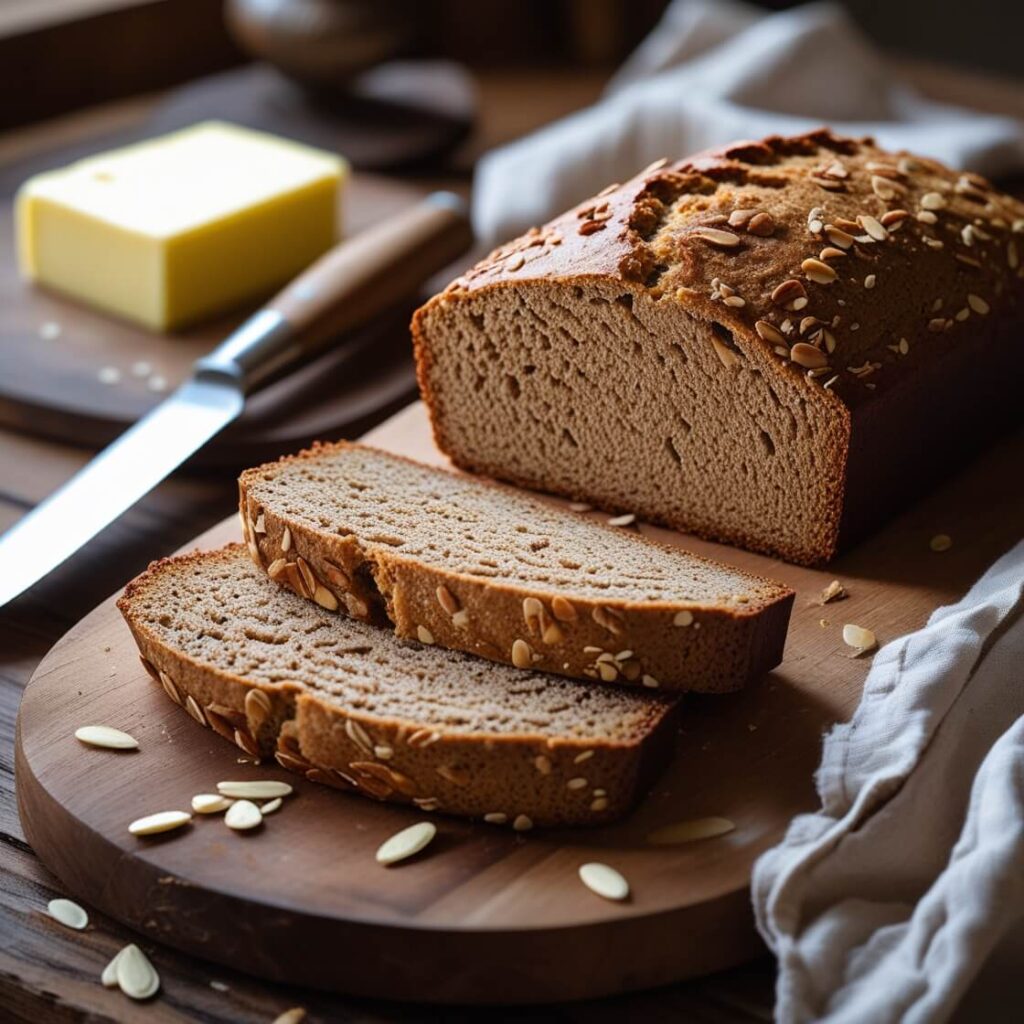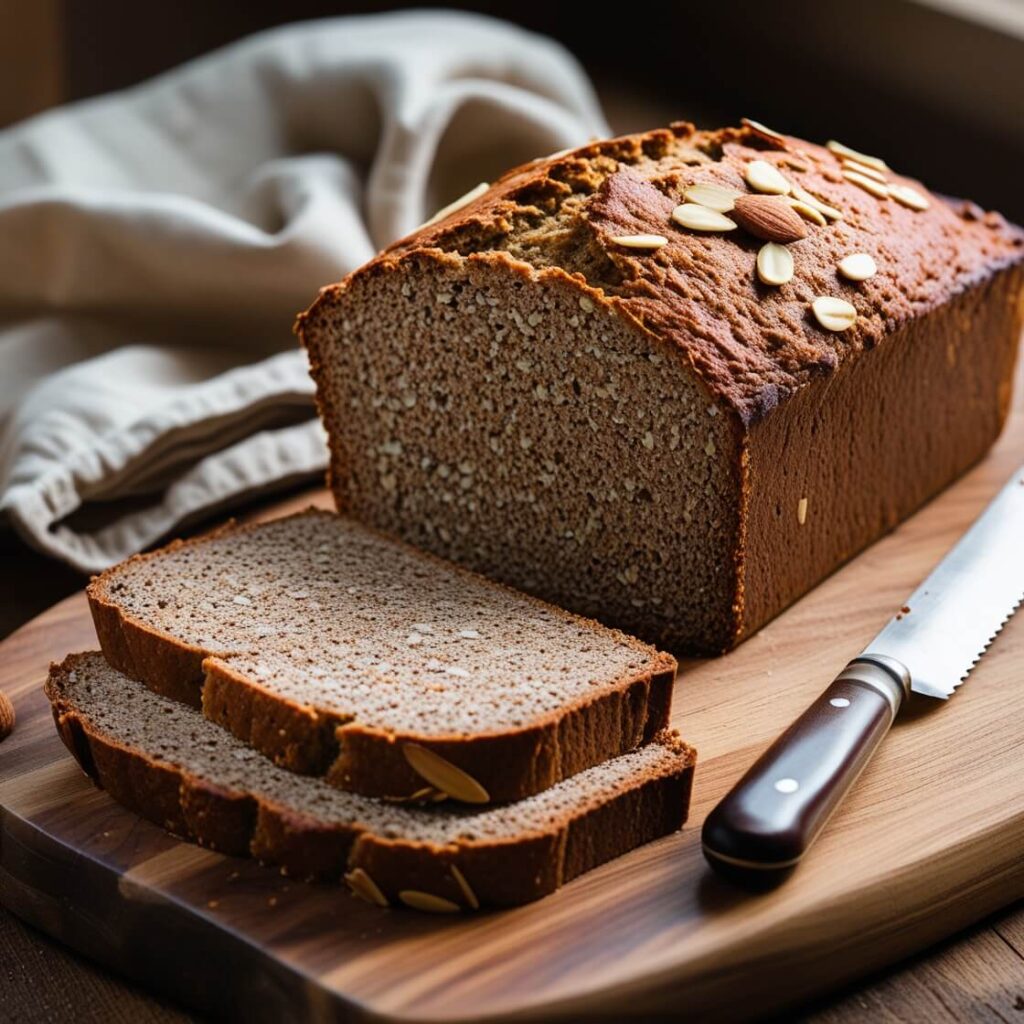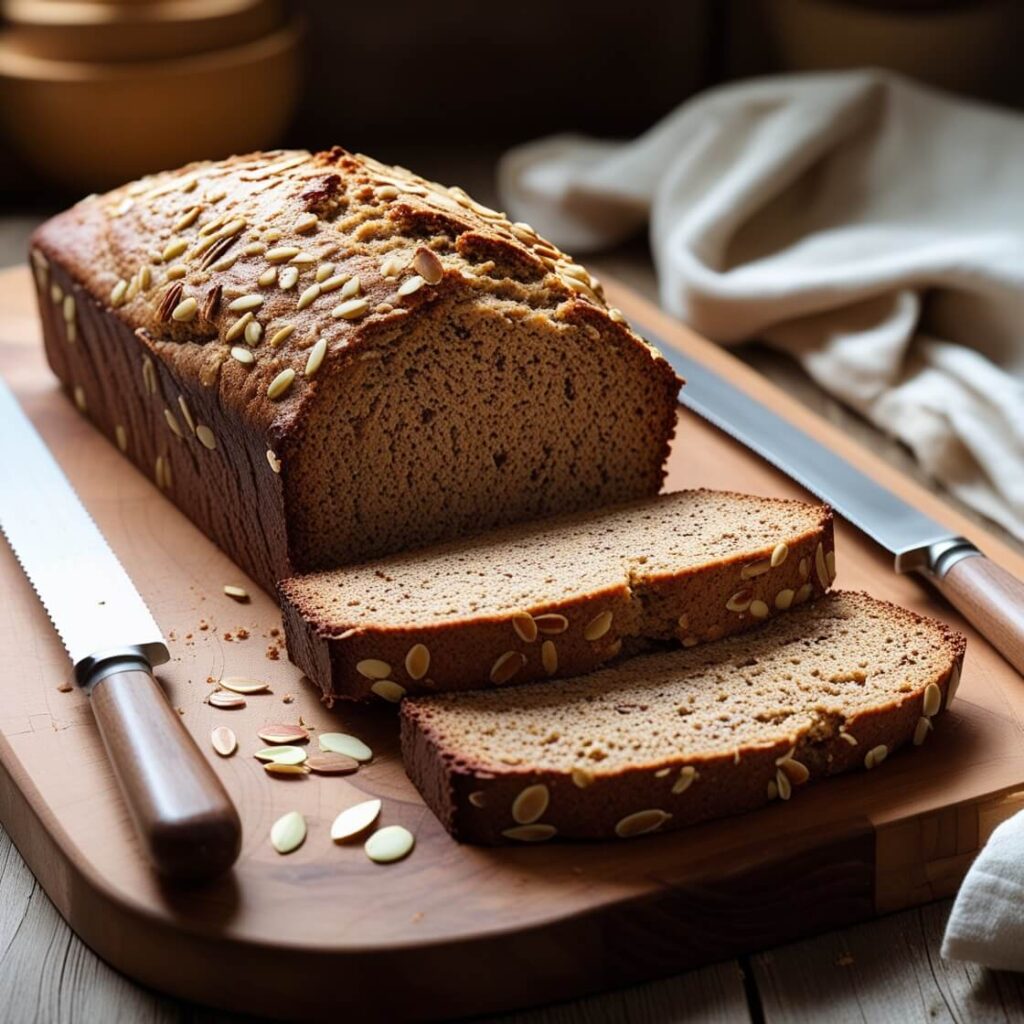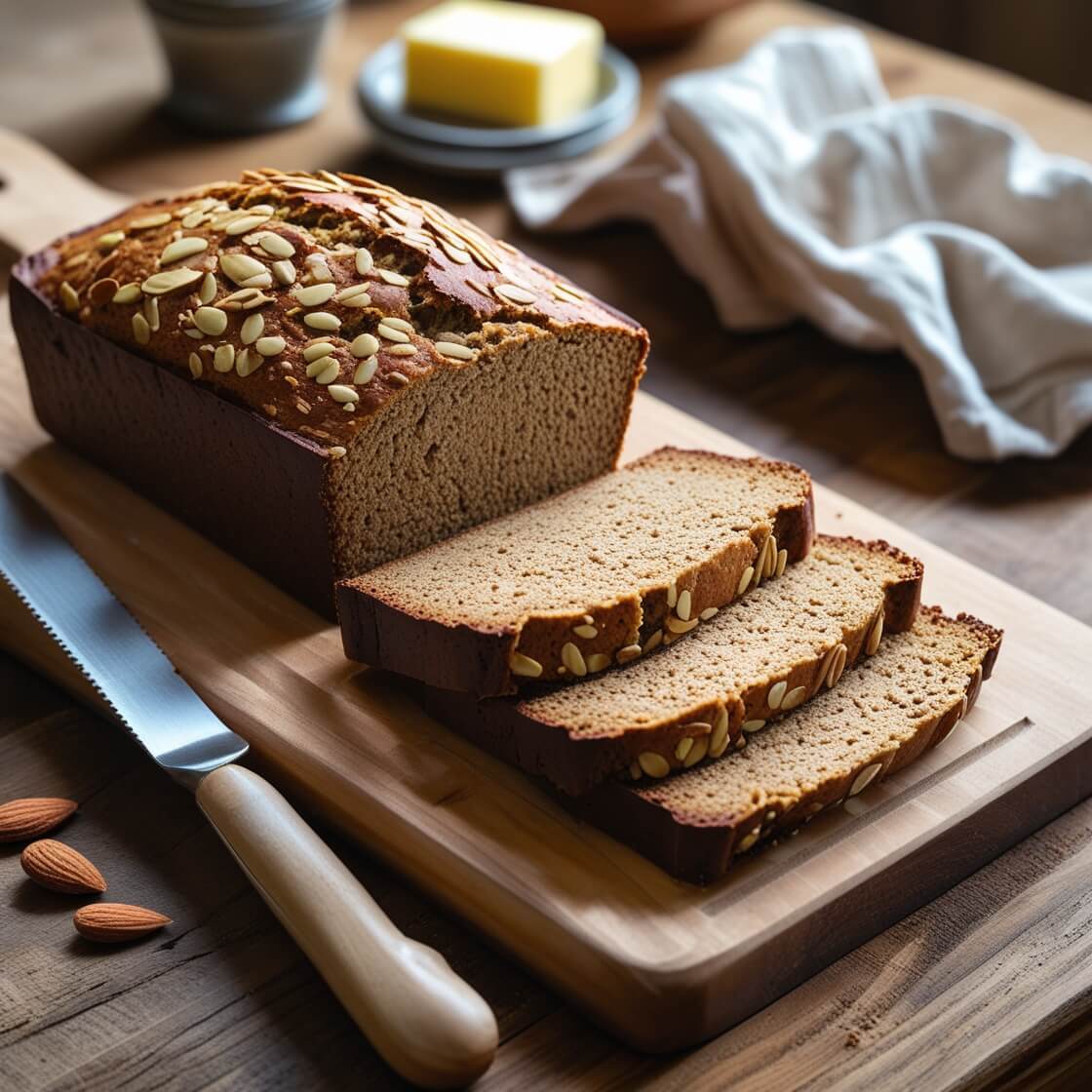Did you know that two slices of whole-wheat bread can actually raise blood sugar higher than six teaspoons of table sugar? This surprising fact creates a real challenge for diabetics who love bread but need to maintain stable blood sugar levels.
Fortunately, homemade bread for diabetics offers a safe alternative when prepared with the right ingredients. By using a combination of fiber-rich flours like almond flour and whole wheat, we can create diabetic-friendly bread that’s both nutritious and delicious. Additionally, ingredients such as psyllium husk, coconut flour, and various seeds help maintain stable blood sugar levels while providing essential nutrients.
In this article, we’ll share a doctor-approved homemade bread for diabetics that doesn’t sacrifice taste or texture. Our recipe balances nutrition with enjoyment, giving you a bread option that fits perfectly into a diabetic diet plan while still satisfying those bread cravings.
Why Diabetics Need Special Bread Recipes
For people with diabetes, bread choices matter significantly more than many realize. The American Diabetes Association recommends choosing whole grain bread or 100 percent whole wheat bread instead of white bread, primarily because of how differently these options affect blood glucose levels.

Homemade Bread for Diabetics – Fresh, healthy, and low-carb!
How regular bread affects blood sugar
Breads can be surprisingly high in carbohydrates, which directly impact blood sugar levels. When you have diabetes, your body doesn’t produce or use insulin effectively to process these carbohydrates. Consequently, blood sugar can rise rapidly after consuming certain types of bread.
The glycemic index (GI) measures how quickly foods raise blood sugar compared to pure glucose. White bread has a remarkably high GI of approximately 100, nearly equivalent to pure glucose itself. In contrast, whole wheat bread has a GI of around 71, making it about 30% lower than white bread.
Processed breads are digested and absorbed faster, causing quicker blood sugar spikes. Dr. Busse explains that bread containing refined carbohydrates typically leads to a rise in blood sugar within 15-30 minutes, with levels peaking at around 60 minutes. This rapid fluctuation is precisely what diabetics need to avoid.
The role of fiber and whole grains
Fiber plays a crucial role in managing diabetes, especially soluble fiber which may slow the absorption of sugar and help improve blood sugar levels. Notably, a study in the New England Journal of Medicine revealed that people with diabetes who consumed 50 grams of fiber daily—particularly soluble fiber—managed their glucose levels more effectively than those eating less fiber.
Whole grains contain all three parts of the grain kernel:
- The bran (outer layer) containing antioxidants, B vitamins, and fiber
- The endosperm (middle layer) providing starchy carbohydrates and proteins
- The germ (inner core) offering healthy fats, B vitamins, and some protein
Research demonstrates that replacing refined grains with whole grains and eating at least 2 servings of whole grains daily may reduce type 2 diabetes risk by 21%. Furthermore, a study of more than 72,000 postmenopausal women found that those consuming the highest amount of whole grains (2 or more servings daily) experienced a remarkable 43% reduced risk of type 2 diabetes compared to those who ate no whole grains.
Doctor recommendations for diabetic diets
Medical professionals suggest specific criteria when selecting bread for diabetics:
- Look for bread with at least 3 grams of fiber per serving
- Choose bread with no added sugars
- Limit bread to slices containing fewer than 15 grams of carbohydrates per slice
- Select varieties where “whole” appears as the first ingredient on the label
- Avoid breads containing dried fruits, which typically have higher carbohydrate content
Susan Weiner, RD, CDE, strongly encourages people with diabetes to choose high-fiber bread with at least three grams of fiber per slice. “Aim for a whole-grain bread with ingredients like oats, quinoa, or bran,” she advises. “They may contain a good portion of fiber, which will improve glycemic response”.
Dr. Routhenstein recommends pairing bread with protein and healthy fats, such as eggs, avocado, or nut butter, to balance the meal and reduce blood sugar spikes. This strategic pairing helps slow down digestion and minimize the impact on blood glucose levels.
Based on these recommendations, creating homemade bread for diabetics becomes not just a preference but a necessary adaptation for better health management.
Key Ingredients for Diabetic-Friendly Bread
Creating a loaf that won’t spike blood glucose requires careful ingredient selection. The foundation of diabetic-friendly bread starts with understanding how each component affects your body’s glycemic response.

Bake smarter with this Homemade Bread for Diabetics!
Whole wheat and almond flour
Regular white flour can be problematic for diabetics due to its high glycemic index of 85 out of 100. Fortunately, better alternatives exist. Almond flour stands out with a remarkably low glycemic index of just 15, making it an excellent choice for homemade bread for diabetics.
Almond flour offers more than just blood sugar benefits. It’s packed with protein, healthy fats, and fiber while containing fewer carbohydrates. One study revealed that increasing almond consumption led to reduced hemoglobin A1C levels, an important marker of long-term blood sugar control.
Whole wheat flour, though higher in carbohydrates than almond flour, provides a much better option than white flour with a glycemic index of just 45. When using whole wheat flour, look for “whole” as the first ingredient on the label to ensure you’re getting the complete nutritional package including the bran, germ, and endosperm.
For exceptional results, consider combining flours. Many successful diabetic bread recipes use a mixture of almond and coconut flour, or almond with small amounts of whole wheat flour.
Low-glycemic sweeteners
Adding sweetness without spiking blood sugar is possible with several doctor-approved alternatives. Monk fruit extract contains zero calories, zero carbs, and is approximately 150 times sweeter than table sugar without raising blood glucose levels.
Stevia, derived from the Stevia rebaudiana plant, has a glycemic index of 0 and only 3 grams of carbs per packet. Dr. Thinh Xuan Ho notes that when baking, you can substitute traditional sugar with these alternatives or use natural options like mashed bananas or unsweetened applesauce.
Other excellent options include:
- Erythritol: Contains very few calories with negligible effects on blood sugar
- Xylitol: Provides 40% fewer calories than sugar with minimal impact on insulin levels
- Yacon syrup: Rich in fiber that helps balance glucose levels
Healthy fats and seeds
Seeds provide exceptional nutritional value in homemade bread for diabetics. They add texture, flavor, and important nutrients that support stable blood sugar. A combination of sunflower, pumpkin, flax, sesame, and chia seeds creates an ideal profile of healthy fats, protein, and fiber.
One tablespoon of chia seeds contains 5 grams of fiber, helping slow digestion and prevent blood sugar spikes. Flaxseeds are particularly beneficial as they’re rich in omega-3 fatty acids and have been shown to improve insulin sensitivity.
Additionally, incorporating hemp hearts adds complete plant protein, whereas pumpkin seeds provide magnesium and zinc, which support overall metabolic health.
Why fiber matters
Fiber plays a crucial role in diabetic bread recipes, primarily because it slows carbohydrate digestion and absorption. The American Diabetes Association recommends that people with diabetes consume at least 14 grams of fiber daily per 1,000 calories.
Research demonstrates that increasing daily fiber intake by 15 grams or to 35 grams can reduce the risk of premature mortality in adults with diabetes. Moreover, higher-fiber diets result in improvements in glycemic control, blood lipids, body weight, and inflammation.
There are two types of fiber that benefit diabetics differently:
- Soluble fiber: Dissolves in water, forms a gel-like material that slows digestion, and helps lower cholesterol and blood sugar
- Insoluble fiber: Doesn’t dissolve in water, adds bulk to stool, and supports digestive health
Throughout numerous clinical trials, increasing fiber intake reduced body weight by an average of 0.56 kg, BMI by 0.36 kg/m², and waist circumference by 1.42 cm, even without reducing caloric intake.
By selecting these key ingredients for your homemade diabetic bread, you create a delicious staple that supports stable blood sugar while providing essential nutrients your body needs.
Doctor-Approved Homemade Bread for Diabetics: The Recipe
After finding the right ingredients for diabetic-friendly bread, it’s time to roll up your sleeves and start baking. This recipe combines scientific principles of glycemic management with delicious flavors to create a bread that’s both nutritious and satisfying.

Diabetic-friendly bread that’s soft and satisfying!
Ingredients list
For our doctor-approved diabetic bread, you’ll need:
- 1 cup almond flour (low glycemic base)
- 1/2 cup whole wheat flour (higher fiber content)
- 3 tablespoons psyllium husk (helps control blood sugar)
- 2 tablespoons chia seeds (adds fiber and healthy fats)
- 1 tablespoon flaxseed meal (supports insulin sensitivity)
- 1/2 teaspoon baking powder
- Pinch of salt
- 2 eggs at room temperature
- 1/4 cup olive oil or melted butter
- 3/4 cup water
- Optional: 2 tablespoons mixed seeds for topping (sunflower, pumpkin, sesame)
Step-by-step instructions
- Preheat your oven to 350°F (175°C) and line a small loaf pan (approximately 7×3.5 inches) with parchment paper.
- In a large bowl, combine all dry ingredients: almond flour, whole wheat flour, psyllium husk, chia seeds, flaxseed meal, baking powder, and salt.
- In a separate bowl, whisk together the eggs, oil or butter, and water until well combined.
- Pour the wet ingredients into the dry ingredients and mix thoroughly until a thick, sticky dough forms.
- Allow the mixture to rest for 15-30 minutes. This crucial step gives the psyllium husk and chia seeds time to absorb moisture, improving the bread’s texture significantly.
- Transfer the dough to your prepared loaf pan. If desired, sprinkle mixed seeds on top for extra nutrition and crunch.
- Smooth the top with a spatula dipped in water to prevent sticking.
Baking time and temperature
Bake at 350°F (175°C) for 45-50 minutes until the top is golden brown and a toothpick inserted into the center comes out clean. For a crispier crust, remove the bread from the pan during the final 10-15 minutes of baking and place directly on the oven rack.
Tips for best texture and taste
First, ensure all ingredients are at room temperature before mixing, as this helps with proper rising. Likewise, don’t rush the resting period—the full 30 minutes allows the fibers to hydrate properly, creating a better texture.
For a lighter loaf, separate the eggs and whip the whites until stiff, then fold them in last. Similarly, try adding a teaspoon of apple cider vinegar or lemon juice to help activate the baking powder.
Finally, this bread tastes best when completely cooled before slicing. For storage, keep at room temperature for up to 2 days or refrigerate for up to 5 days. Alternatively, slice the bread and freeze individual portions to toast as needed.
Smart Substitutions and Variations
Personalizing your diabetic bread recipe opens up a world of possibilities while maintaining blood sugar control. With a few smart substitutions, you can adapt the basic recipe to accommodate additional dietary needs or simply add variety to your weekly bread-making routine.
Dairy-free alternatives
For those avoiding dairy, olive oil or avocado oil work perfectly as 1:1 substitutes in diabetic bread recipes. Indeed, these healthy fats add rich flavor while supporting stable blood glucose levels. Alternatively, for recipes calling for milk, unsweetened almond or coconut milk beverages contain only 0-0.5 net carbs per ¼ cup, making them excellent low-glycemic alternatives.
Nut-free options
Sunflower seed meal offers a fantastic alternative for those with nut allergies. To create it, simply blitz sunflower seeds in a high-speed blender until they reach a flour-like consistency. Another excellent option is oat fiber, which is made from the non-digestible outer husk of oats and contains virtually zero net carbs. Generally, psyllium husk powder can also replace part of the nut flour while adding essential fiber to your bread.
Low-carb flour swaps
Beyond almond flour, several other low-carb flour options exist for homemade bread for diabetics:
- Coconut flour: At 4g net carbs per two tablespoons, it’s highly absorbent
- Flaxseed meal: With just 1g net carbs per two tablespoons, it’s among the lowest-carb options
- Walnut flour: Contains only 1g net carbs per serving and adds a rich, nutty flavor
- Soy flour: Offers 5.4g net carbs per ¼ cup plus additional protein
Bean flours made from chickpeas or fava beans can also add protein, fiber, and iron to your diabetic bread.
Flavor add-ins: herbs, seeds, and spices
Enhance both taste and health benefits by incorporating herbs and spices into your homemade bread for diabetics. Cinnamon stands out primarily for its ability to effectively reduce high blood sugar levels and improve glycemic control. Likewise, turmeric can help lower blood glucose while providing anti-inflammatory benefits.
For savory variations, add rosemary, which traditional healers have used to treat diabetes, or holy basil (tulsi), known for lowering blood glucose in type 2 diabetics. Even so, don’t forget about seed add-ins such as chia, which provide 5 grams of fiber per tablespoon, helping slow digestion and prevent blood sugar spikes.
How to Store and Freeze Homemade Diabetic Bread
Proper storage of your homemade diabetic bread is just as important as the careful selection of ingredients. With the right techniques, you can maintain freshness and even potentially improve the bread’s glycemic properties.

No sugar, no guilt – just perfect Homemade Bread!
Room temperature storage tips
Homemade diabetic bread typically lasts 2-3 days at room temperature, considerably less time than store-bought varieties that contain preservatives. To maximize freshness, store your bread in an airtight container in a cool, dark place in your pantry. This extra layer of protection helps maintain moisture and flavor while keeping air out.
Surprisingly, refrigeration isn’t always recommended as the first option. The temperature and humidity inside your refrigerator can actually cause bread to spoil faster in some cases. However, if you live in a particularly humid environment, you might need to move your bread to the refrigerator sooner to prevent mold growth.
Freezing and reheating instructions
Freezing offers two major benefits: extended storage time and potentially lower glycemic impact. Studies show that frozen and reheated bread has a slower digestion rate than fresh bread, leading to a lower rise in blood sugar. This occurs because freezing creates resistant starches through a process called retrogradation, making them more fiber-like and slower to digest.
For best results:
- Slice your bread completely before freezing for convenient portion control
- Wrap tightly in plastic or place in a freezer-safe bag with air pressed out
- Label with the date frozen
- Freeze for up to 6 months
When ready to eat, toast the frozen slices directly from the freezer—no need to thaw first.
How long it stays fresh
Storage duration varies by method:
- Room temperature: 2-3 days for homemade diabetic bread
- Refrigeration: Extends shelf life by 3-5 additional days
- Freezer: Maintains quality for up to 6 months
Throughout storage, whole grain breads generally have a shorter shelf life than white bread due to their higher moisture content. As well as providing health benefits, some ingredients like polyols can actually extend shelf life, keeping bread fresher for up to 10 days versus the typical 4 days.
Conclusion
Baking homemade bread for diabetics ultimately transforms what was once a forbidden food into a healthful addition to your meal plan. Throughout this article, we’ve explored why conventional bread poses challenges for blood sugar management and how thoughtfully selected ingredients create a safer alternative. Undoubtedly, the combination of almond flour, whole wheat flour, and fiber-rich additions like psyllium husk and seeds makes a significant difference in glycemic response.
The doctor-approved recipe we’ve shared balances nutrition with flavor, essentially giving you the best of both worlds. Unlike store-bought varieties, this bread contains no hidden sugars or refined carbohydrates that might sabotage your glucose levels. Additionally, the customization options ensure you’ll never tire of the same loaf – try herbs for an Italian twist or cinnamon for a warming flavor that actually helps stabilize blood sugar.
Perhaps most importantly, this bread fits seamlessly into a diabetic lifestyle without feeling like a compromise. The storage techniques we’ve discussed further enhance its convenience, while freezing might even improve its glycemic properties. After all, managing diabetes doesn’t mean eliminating food pleasures – it means finding smarter alternatives that support your health goals while still satisfying those bread cravings.
Though diabetes requires careful food choices, homemade bread can certainly remain on your menu when prepared with the right ingredients. This recipe proves that dietary restrictions need not limit culinary enjoyment. With a bit of preparation and knowledge about how different components affect your body, you can confidently enjoy bread that tastes good and feels good after eating. Your journey toward better blood sugar control starts in your kitchen – one delicious slice at a time.
About HealthyBlog365
Welcome to HealthyBlog365, your go-to destination for all things food and drink. We believe that every meal is not just a way to nourish your body but also a meaningful connection with yourself and your loved ones.
HealthyBlog365 was created with a mission to inspire healthy living through nutritious meals and refreshing beverages. Here, you’ll discover a treasure trove of creative recipes, kitchen tips, and healthy eating trends tailored to fit modern lifestyles.
 What can you find on HealthyBlog365?
What can you find on HealthyBlog365?
- Delicious and easy-to-make recipes: From simple meals for busy mornings to wholesome dinners for family gatherings, we’ve got you covered for every occasion.
- Nutritious drinks: Explore recipes for juices, smoothies, detox teas, and drinks that cleanse your body, boost your mood, and energize your day.
- Guides on eating habits: Get detailed insights into popular diets like keto, low-carb, and vegetarian-friendly meal plans.
- Kitchen hacks: Discover smart tips to save time, preserve food, and cook more efficiently.
We are committed to providing high-quality content, staying up-to-date with the latest trends, and maintaining a balance between nutrition and flavor.
 Connect with HealthyBlog365 on Social Media
Connect with HealthyBlog365 on Social Media
Join the HealthyBlog365 community on social media platforms to stay updated with our latest posts, watch exciting tutorials, and share your food stories with us:
Facebook: Follow us here to stay updated with our latest posts and join our community.
Instagram: Check us out here for inspiring visuals and ideas.
Pinterest: Pin with us here to save creative ideas you’ll love.
YouTube: Subscribe here for detailed tutorials and exciting videos.
 Thank You for Supporting HealthyBlog365!
Thank You for Supporting HealthyBlog365!
We aim to build a connected community where everyone can share and learn from each other. If you have any questions or suggestions, don’t hesitate to reach out to us via social media or our website.
We hope you have a wonderful time on HealthyBlog365 and find new inspiration for your healthy culinary journey!

